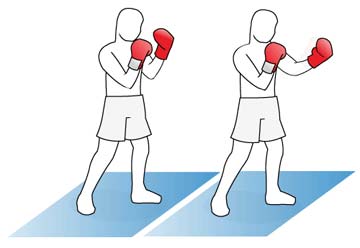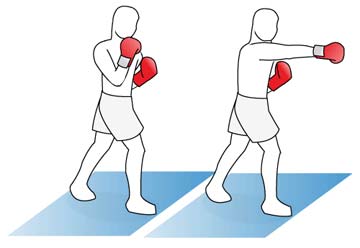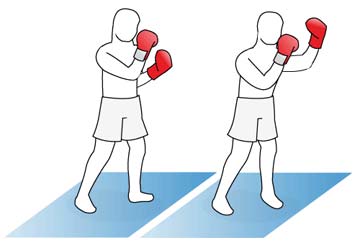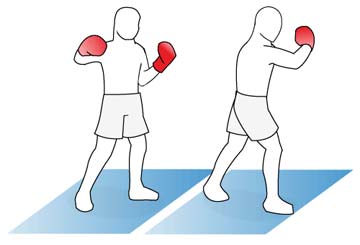Boxing moves
Before you launch into a training regime, get clued up by checking out these basic punches. For easy-to-follow diagrams of each punch, have a look at a very comprehensive book called Boxing Greats by Marshell Cavendish.
- The jab is a move which it is worth spending time perfecting. It is used frequently and a well-practiced technique can prove a solid foundation to your match. The most common interpretation of this punch is a straight strike from the left hand towards the opponent’s head.

The Jab
- If you sense you are about to be on the receiving end of a jab, act quickly with a right cross. Dip so that the jab passes over your shoulder and strike your right hand on your opponent’s jaw.

Right Cross
- Remember that the more punches, particularly jabs, you throw towards the body of your opponent, the more likely his or her hands are likely to lower to protect themselves. This leaves the head and chin vulnerable.
- The uppercut is a useful move when your opponent is close to you. With an upwards swipe, landing underneath your opponent’s chin, your forearm should make a 90 degree angle with your upper arm. The palm of your fist should be facing upwards and the uppercut should knock your opponent’s head back.

The Uppercut
- The hook is another short punch. The trick to this is the surprise element. If the move starts away from your opponent’s forward stare, he is likely to be unprepared to receive such a blow to the central body. The hook is versatile and effective with either hand. It can take a few seconds for the recipient to recover – valuable time in which you can deliver another punch.

The Hook
Boxing equipment
- If you are just starting out in boxing, it is vital that you shop around for your equipment. Not only will this mean you will get the best prices, you will also benefit from useful advice from those experienced in the sport.
- You do not need to spend a fortune on equipment – it is drive, perseverance and perspiration which will win you matches, not the latest or most expensive gear.
- Before you face opponents in full-blown matches, you will be spending most of your training time getting angry with a heavy punch bag at your training club or gym. Punches will not be thrown back at you until you fight another boxer, which means that you do not need to spend money on a mouth guard or body protection yet.
- Shorts, a tee-shirt, bag gloves (specially designed for punching a heavy bag) and hand wraps are all you need to begin with. Hand wraps are lengths of fabric which you wrap around your hands to protect them before you put your gloves on. Bag gloves differ from competition gloves, also known as sparring gloves, because they are only designed to strike punch bags. They can become worn through quite quickly, so it is worth investing in a high quality pair.
- When it comes to stepping into the ring and coming face to face with another boxer, as opposed to a punch bag, you will take some heavy knocks. Your safety is paramount, so you should not scrimp on your protection – especially head gear and mouth guards.
- This How To Box website offers some sound detailed advice on equipment. This other useful website also gives tips on what to look for if you decide to buy your own punch bag instead of using one in a gym or club.
